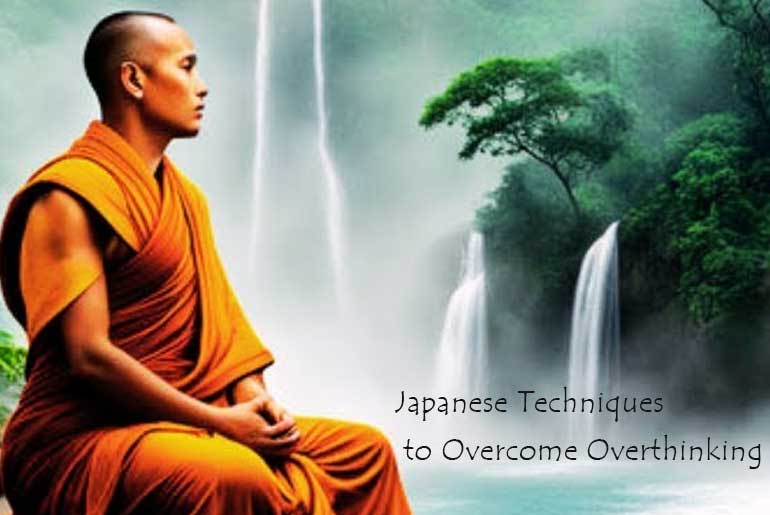Japanese techniques for overcoming overthinking often emphasize mindfulness, simplicity, and practical action. Key practices include “Shinrin-yoku” or forest bathing, which helps calm the mind and reduce stress by immersing oneself in nature. “Ikigai”, the concept of finding purpose or meaning in life, encourages individuals to focus on what brings them joy and satisfaction, shifting their mindset away from excessive worry. Additionally, “Kaizen”, the practice of continuous improvement, promotes small, manageable changes to improve well-being and reduce anxiety. These Japanese techniques collectively foster a more balanced and present-focused approach to managing overthinking and stress.
1. Zazen (Seated Meditation)
- What It Is: Zazen is a form of seated meditation central to Zen Buddhism. Practitioners sit in a specific posture, typically cross-legged, with a straight back and focused on their breathing.
- How It Helps: This practice encourages observing thoughts without attachment or judgment, leading to mental calmness and enhanced mindfulness. Regular practice can help you detach from excessive rumination and develop a clearer, more centered mind.
2. Shinrin-yoku (Forest Bathing)
- What It Is: Shinrin-yoku translates to “forest bathing” and involves immersing oneself in a forest environment to engage with nature through all the senses.
- How It Helps: This practice reduces stress and mental fatigue by offering a break from urban life and electronic distractions. The natural setting promotes relaxation, which can clear the mind and alleviate overthinking.
3. Ikigai (Finding Your Purpose)
- What It Is: Ikigai is about discovering your reason for being by aligning four elements: what you love, what you’re good at, what the world needs, and what you can be paid for.
- How It Helps: Identifying and pursuing your ikigai provides a sense of direction and purpose, helping to focus thoughts and reduce the mental clutter associated with a lack of purpose or aimlessness.
4. Wabi-sabi (Embracing Imperfection)
- What It Is: Wabi-sabi is the Japanese aesthetic of appreciating the beauty in imperfection, impermanence, and simplicity.
- How It Helps: By embracing the natural course of life and the beauty in flaws, wabi-sabi helps alleviate the pressure of striving for perfection. This mindset can reduce anxiety and overthinking related to achieving ideal outcomes.
5. Haragei (Subtle Communication)
- What It Is: Haragei refers to the art of subtle, non-verbal communication and understanding. It involves reading and conveying feelings and intentions without explicit expression.
- How It Helps: By focusing on intuitive understanding rather than verbal analysis, haragei can reduce the cognitive load and stress associated with overanalyzing conversations and interactions.
6. Mushin (Mind Without Disturbance)
- What It Is: Mushin is a mental state where the mind is free from distractions and preconceptions, often achieved through practices like martial arts or meditation.
- How It Helps: This state promotes clarity and spontaneity in actions, allowing you to act decisively without being hindered by overthinking. It encourages a focus on the present moment and enhances mental agility.
7. Kaizen (Continuous Improvement)
- What It Is: Kaizen is the philosophy of making small, incremental improvements over time rather than seeking drastic changes.
- How It Helps: By focusing on gradual progress, kaizen helps reduce the overwhelming nature of large goals and projects. This approach fosters a steady, manageable path forward, reducing the tendency to overthink or become paralyzed by the scope of tasks.
8. Mindful Tea Ceremony (Chanoyu)
- What It Is: The Japanese tea ceremony, or chanoyu, is a ritualistic practice involving the careful preparation and consumption of tea, emphasizing mindfulness and grace.
- How It Helps: This practice provides a meditative experience that encourages present-moment awareness and tranquility. It helps to cultivate mental calmness and reduces the mental clutter associated with daily stressors.
9. Furoshiki (Wrapping Cloth)
- What It Is: Furoshiki is the traditional Japanese art of wrapping items in cloth, used both functionally and artistically.
- How It Helps: The mindful practice of furoshiki encourages a purposeful approach to tasks, fostering focus and reducing distractions. This can help in cultivating a clearer, more organized mind.
10. Japanese Calligraphy (Shodo)
- What It Is: Shodo is the art of Japanese calligraphy, involving writing with brush and ink in an expressive, fluid manner.
- How It Helps: The practice of shodo requires concentration and precision, offering a meditative and calming experience. It helps clear the mind, reduce stress, and manage overthinking through focused, deliberate action.
Incorporating these Japanese techniques into your routine can help you develop mental clarity, reduce stress, and manage overthinking by fostering mindfulness, purpose, and a deeper connection with the present moment.
Disclaimer:
The information contained in this article is for educational and informational purposes only and is not intended as a health advice. We would ask you to consult a qualified professional or medical expert to gain additional knowledge before you choose to consume any product or perform any exercise.







